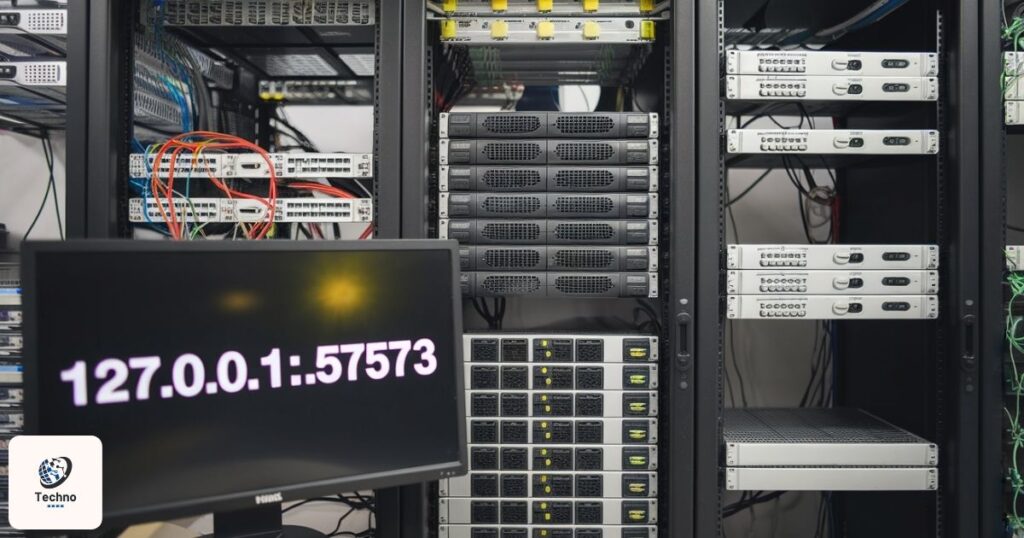Are you pulling your hair out over mysterious connection issues on your local machine? You’re not alone. In the world of software development and network setup, the combination of IP address 127.0.0.1 and port 57573 can be both a blessing and a curse. Let’s explore into the nitty-gritty of this loopback address and unravel the secrets to smooth network communications.
Key Takeaways
- In 2024, mastering 127.0.0.1:57573 is crucial for network administrators and developers for efficient testing and debugging.
- The loopback address 127.0.0.1 is vital in creating isolated testing environments that mimic real-world scenarios.
- Port 57573 is ideal for development environments due to its high number, reducing conflicts with standard services.
- Common causes of connection issues include port conflicts, firewall blockages, and configuration errors.
- Modern debugging tools offer advanced insights into network traffic and port usage, which is essential for managing local services.
- Advanced troubleshooting techniques often involve deep analysis of network interactions and system logs.
- Proper firewall configuration is crucial for maintaining secure yet functional network communications on 127.0.0.1:57573.
- Future trends in local networking include containerization technologies and AI-integrated network diagnostics tools.
- Consistently using port 57573 across development teams can standardize development processes and improve collaboration.
- Enhancing security on localhost connections, even for local services, is a best practice for robust application development.
What is a Port and Why is it Important?

Think of ports as the doorways to your computer’s network traffic. Just like a busy airport needs multiple gates to handle different flights, your computer uses ports to manage various network interactions. Port 57573 is one of these gateways, often used for specific network applications or testing environments.
In the grand scheme of network setup, ports are the unsung heroes that keep data transfer organized and efficient. They ensure that when you’re browsing the web, chatting with friends, or running a local server, each application gets its own channel to communicate through. Without ports, your computer would be like a house with only one door – chaotic and inefficient.
Understanding Port 57573
Port 57573 isn’t your average, run-of-the-mill port. It’s what we call a high-numbered port, often used in development environments for testing and debugging. Unlike well-known ports like 80 for HTTP or 443 for HTTPS, 57573 is less likely to conflict with standard services, making it ideal for application development.
This unique port shines in scenarios where you need to run multiple instances of an application or when you’re setting up a test server. It’s like having a secret workshop in your house where you can tinker with inventions without disturbing the rest of your home. For network administrators and developers, understanding the nuances of port 57573 can be a game-changer in managing local services efficiently.
What is 127.0.0.1 and its Role in Networking?
The IP address 127.0.0.1 is like your computer’s home address on the network. It’s a special loopback address that always points back to your own machine. When you use this address, you’re telling your computer to talk to itself, which is incredibly useful for testing and debugging without affecting other devices on the network.
In the world of network setup, 127.0.0.1 is the go-to address for local services. It’s the foundation of localhost, allowing developers to run web servers, databases, and other applications on their own machines as if they were accessing them from the internet. This loopback address is essential for creating isolated testing environments that mimic real-world scenarios without the risks associated with live networks.
How Does Localhost Help in Development?
Localhost, accessed via 127.0.0.1, is a developer’s best friend in 2024. It provides a safe playground for testing and debugging applications before they face the wild west of the internet. By using localhost, developers can simulate network environments on their local machine, catching bugs and optimizing performance without affecting live systems.
The beauty of localhost lies in its versatility. Whether you’re working on a complex web application or a simple script, localhost allows you to test network interactions in isolation. This means faster development cycles, easier troubleshooting, and the ability to experiment with new features without fear of breaking production systems. It’s like having a mini-internet right on your computer, ready for all your development processes.
What are Common Causes of Connection Failures?
Even the most experienced network administrators can stumble when it comes to connection issues with 127.0.0.1:57573. Understanding the common culprits behind these failures is key to maintaining smooth network communications. From port conflicts to firewall blockages, let’s break down the usual suspects that can throw a wrench in your local services.
Knowing these common causes is half the battle in troubleshooting connection problems. By familiarizing yourself with these issues, you’ll be better equipped to diagnose and resolve network problems quickly, keeping your development environments running smoothly and your productivity high.
Port Already in Use
One of the most frequent headaches in network setup is discovering that port 57573 is already occupied. This port conflict occurs when another application or service has already claimed the port you’re trying to use. It’s like showing up to a reserved table at a restaurant only to find someone else sitting there.
Firewall Blockages
Firewall settings can be both a blessing and a curse in network communications. While they’re essential for security, overzealous firewalls can block legitimate network traffic to and from port 57573. This is akin to a bouncer at a club who’s a bit too strict, turning away even the VIP guests.
Configuration Errors
Misconfiguration is a silent killer of smooth network interactions. Whether it’s a typo in an IP address or an incorrect port number, these small errors can lead to big problems. It’s like trying to mail a letter with the wrong address – it’ll never reach its destination no matter how many times you send it.
Tools for Managing 127.0.0.1:57573
In 2024, the toolkit for managing local services on 127.0.0.1:57573 has evolved significantly. Modern debugging tools offer unprecedented insights into network traffic and port usage. From command-line utilities to graphical interfaces, these tools are essential for any network administrator or developer working with localhost.
Here’s a table comparing some popular tools for managing 127.0.0.1:57573:
| Tool Name | Platform | Key Features | Best For |
| Netstat | All | Port usage, connections | Quick checks |
| Wireshark | All | Detailed packet analysis | Deep troubleshooting |
| TCPView | Windows | Real-time connection viewing | Visual learners |
| lsof | Unix/Linux | File and port usage | Advanced users |
| Postman | All | API testing on localhost | API developers |
These tools can be your best allies in troubleshooting connection issues and optimizing your local machine’s network performance. By mastering these utilities, you’ll be well-equipped to handle any network problems that come your way.
Advanced Troubleshooting Fixing Tips for Connection Issues on Port 57573
When basic troubleshooting doesn’t resolve your connection issues on port 57573, it’s time to dig deeper. Here are some advanced tips to help you tackle stubborn problems:
- Use packet sniffers like Wireshark to analyze network traffic and identify unusual patterns or blocked connections.
- Check system and application logs for error messages related to port 57573 or network communications.
- Temporarily disable your firewall and antivirus to determine if they’re causing the connection issues.
- Use command-line tools like ‘netstat’ or ‘lsof’ to identify which processes use port 57573.
- Try binding your application to a different high-numbered port to rule out specific port 57573 issues.
- Verify that your application has the necessary permissions to bind to ports on your local machine.
- Use port scanning tools to check if port 57573 is truly open and accessible.
- Examine your network setup for any recent changes that might have affected localhost communications.
- Consider using containerization tools like Docker to isolate your application and its network environment.
- If all else fails, use a system restore point to revert recent changes that might have caused the issue.
Remember, these advanced techniques require careful application and a good understanding of your system’s network interactions. Always back up important data before making significant changes to your network setup.
How to Troubleshoot Connection Issues on Port 57573
Effective troubleshooting of connection issues on port 57573 requires a systematic approach. Start by verifying that the port is actually the problem – use commands like netstat to check if it’s in use or listening. If the port is open but you’re still experiencing issues, the problem might lie in your application’s configuration or network setup.
Next, check your firewall settings. Many connection issues stem from overly restrictive firewalls blocking local services. If you’ve recently updated your security software, this could be the culprit. Don’t forget to test your connection from different applications or browsers to isolate the issue further.
Case Studies Involving 127.0.0.1:57573
Real-world examples often provide the best insights into troubleshooting complex network problems. Let’s look at a case where a development team was struggling with intermittent connection issues on their test server running on 127.0.0.1:57573. After days of frustration, they discovered that a recently installed VPN service was interfering with their localhost connections.
Another interesting case involved a network administrator who couldn’t figure out why their debugging tools weren’t connecting to port 57573. The culprit? A typo in the firewall configuration that was blocking odd-numbered ports above 50000. These cases highlight the importance of thorough network diagnostics and attention to detail in network setup.
Benefits of Using Port 57573 for Development
- Isolation: Port 57573 provides strong isolation for development environments, minimizing conflicts with standard services and allowing multiple testing setups without interference.
- Security: As an uncommon port, 57573 reduces exposure to automated attacks, adding an extra layer of security for local services. Still, proper security measures are essential.
- Efficiency: Standardizing on port 57573 boosts efficiency by simplifying network setup, minimizing configuration errors, and separating development traffic for easier monitoring and performance optimization.
How to Enhance Security on Port 57573
While localhost connections are inherently more secure than external ones, it’s still crucial to implement robust security measures. Start by ensuring that your firewall settings are configured to only allow necessary network traffic on port 57573. This creates a first line of defense against potential exploits.
Consider implementing encryption for sensitive data, even on localhost. While it might seem overkill, it’s a good practice that can prevent issues if your application ever moves to a non-local environment. Additionally, regularly audit your local services to ensure that only required applications are using port 57573, minimizing potential attack surfaces.
Configuring Firewall Settings for 127.0.0.1:57573
Proper firewall configuration is crucial for maintaining secure yet functional network communications on 127.0.0.1:57573. Start by identifying which applications need access to this port and create specific rules for them. This targeted approach ensures that your firewall doesn’t become a bottleneck for legitimate network traffic.
Remember to test your firewall settings thoroughly after making changes. Use network diagnostic tools to verify that port 57573 is accessible to the right applications while remaining secure from unwanted access. It’s a balancing act between security and functionality, but with careful configuration, you can achieve both.
Future Trends in Local Networking

As we look ahead in 2024, the landscape of local networking continues to evolve. Containerization technologies are changing how we approach localhost development, offering even more isolated and reproducible testing environments. We’re also seeing a rise in automated network diagnostics tools that can predict and prevent connection issues before they occur.
Another exciting trend is the integration of AI in network setup and troubleshooting. These intelligent systems can analyze network traffic patterns and suggest optimizations for your local services, potentially revolutionizing how we manage development environments. As always, staying informed about these trends will be crucial for network administrators and developers alike.
Read Also: Xmegle: A Unique Social Platform Shaping Online Connections
FAQs
What is 127.0.0.1:57573?
127.0.0.1:57573 refers to your local machine (localhost) using port 57573 for network communication, often used in development or testing environments.
Why is my connection to 127.0.0.1:57573 failing?
Connection failure may occur due to firewall settings, port conflicts, or the application not running on port 57573.
How can I fix connection issues on Port 57573?
Check if the application is running, ensure the port is open in the firewall, and verify that there are no conflicts with other services using the same port.
What tools can help troubleshoot 127.0.0.1:57573 problems?
Tools like Telnet, Netstat, and network monitoring software (Wireshark) can help diagnose port connection issues.
What is meant by 127.0.0.1 and localhost?
127.0.0.1 is the loopback address, representing localhost, which refers to your own computer in network terms.
Conclusion
Mastering 127.0.0.1:57573 is more than just a technical skill – it’s an art form. From understanding the basics of ports and localhost to implementing advanced security measures and troubleshooting techniques, this knowledge is invaluable in today’s fast-paced development world. Remember, every great application starts with a solid local machine setup.
As you continue your journey in network communications and application development, keep exploring and experimenting with your localhost environment. The more comfortable you become with managing 127.0.0.1:57573, the more efficient and effective your development processes will become. Here’s to smooth network interactions and bug-free local services in all your future projects!

As a seasoned blog writer with three years of experience, I specialize in delivering insightful and informative content on global technology trends through my personal blog, TechnoZees.

